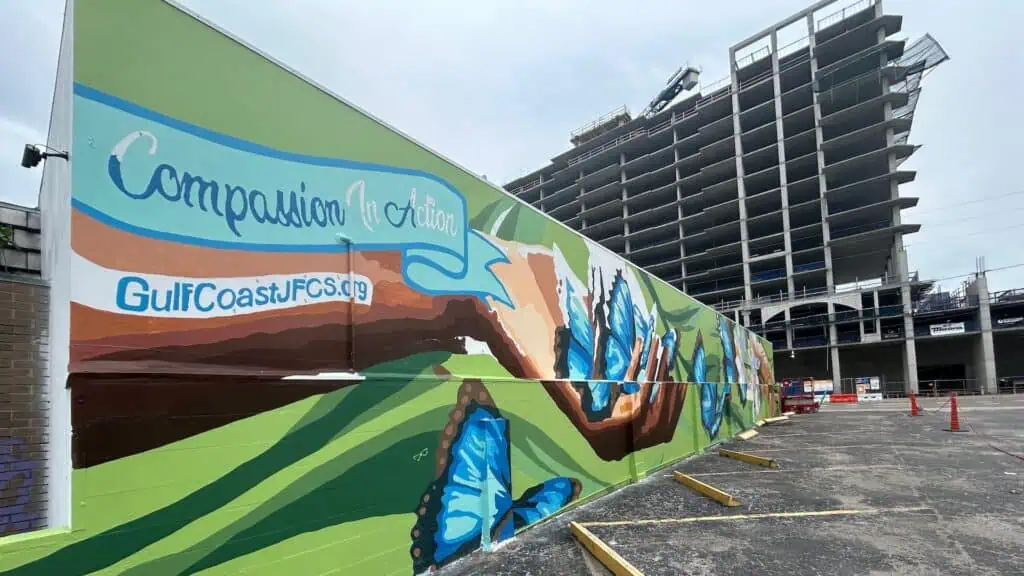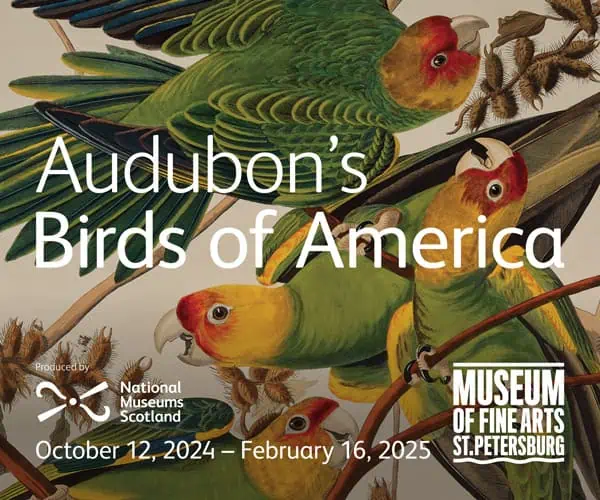On Mother’s Day weekend, more than 600 volunteers tried their hand at mural painting as part of a paint-by-number community mural sponsored by Gulf Coast Jewish Family and Community Services. The colorful painting adorns the west-facing wall of a former optometry office on 1st Avenue North near the Edge District.
The mural contains a few hidden tributes to the man behind the building, Philip Benjamin, who built it in 1969 for his thriving optometry business. It was designed by Philip’s cousin, prominent mid-century architect Sanford Goldman. Goldman trained with the renowned Frank Lloyd Wright for a year before opening his architecture practice in St. Petersburg, where he and Philip grew up as part of a small but tight-knit Jewish community.
ADVERTISEMENT

Philip Benjamin moved to St. Petersburg when he was just four years old to join his mother’s family, the Goldmans, who had settled here a few years earlier and started thriving businesses. May Goldman Benjamin quickly became an active member of the community, working at her family’s stores, Goldman’s Jewelry and Bell Luggage, serving as the first President of the St. Petersburg chapter of Hadassah, and joining Congregation B’nai Israel, located just a stone’s throw from her home on Arlington Avenue. She served as a role model to her son Philip, who graduated high school at 16 years old before heading off to optometry school in Chicago, with a detour to serve in the Army during WWII. After the war, Philip moved back to St. Petersburg and worked at Bay Pines Veterans Hospital before opening his own practice. It was there that he met Marilyn Haliczer, daughter of one of St. Pete’s first Jewish residents, who worked for Dr. Benjamin on and off. They married a few years later.
In those years much of Jewish community life was centered around Arlington Avenue, where both of the city’s synagogues were located (Congregation B’nai Israel was at 1039 Arlington Avenue, now a surface parking lot, and Temple Beth El was at 757 Arlington; today the building is a law office.) Across from the Congregation B’nai Israel, at 1099 Arlington Avenue, sat a hotel named the Empire, with a kosher restaurant that opened in 1945; it quickly became the place to hold large seders in St. Petersburg.
It was therefore fitting that Philip Benjamin should build this optometry office on a lot straddling Arlington Avenue and 1st Avenue North in 1969. By that time he had become a leading figure in St. Petersburg, having quietly but steadfastly helped to break down many of the city’s racial and religious barriers. Dr. Benjamin was the first to open his waiting room to black patients during regular business hours, believing that any citizen had the right to treatment, regardless of the color of their skin or their ability to pay. Some of his white patients never returned.
Benjamin also helped shine a light on the city’s simmering anti-semitism. For decades, “gentiles only” notices hung at hotels, restaurants, and clubs, and the Secretary of the Chamber of Commerce, Jim Coad, made blatantly antisemitic comments, saying in 1924 “I believe the time has come to draw the line against all foreigners and make this a 100% American and Gentile city.” Marilyn Benjamin even recalls her father telling her about a sign placed on Fourth Street North, leading into the city from the Gandy Bridge in the 1920s that read: “Gentiles Only – No Jews Wanted Here.”
In the early 1960s, Philip Benjamin was nominated for membership in the Lion’s Club, having performed free eye exams for the club for more than 17 years. When it came time for the vote, he was blackballed. His wife Marilyn remembers the commotion that caused. “The colleague who had nominated him was so angry about it that he said he was resigning.” Several other members of the club threatened to follow suit. “It caused such a stir that they had a revote and Phillip was accepted. I asked him why he would want to be a member of a group that had tried to blackball him and he said, “I have to show them that I can go forward and I hope they can too. And that they should not do this again to anyone else.”
Later, Benjamin served as the Chairman of the Board of St. Petersburg Junior College, where he led the implementation of the school’s affirmative action policies. Minority representation in the staff and faculty grew ten-fold.
Dr. Benjamin passed away in 1998, but you can still see his name on a building at St. Petersburg College and the Philip Benjamin Tower, part of a retirement community he helped establish. If you look closely, you can also see a tribute to him in the new mural on his old optometry building. Artist Alyssa Marie hid a pair of eyeglass frames in the painting as a tribute to Philip Benjamin, along with a pair of Shabbat candles to honor Philip’s wife Marilyn. On the Saturday before Mother’s Day Marilyn herself took on the job of painting the eyeglasses in the mural.
When asked what her husband might think of the mural project, Marilyn replied “I think my husband would be thrilled to death to know that something like this is being done. He would have said ‘yes, yes, yes’ if he had been asked.”
The mural project was organized by Gulf Coast Jewish Community and Family Services . Gulf Coast JFCS helps the most vulnerable individuals throughout the community, from babies to seniors, find safety, comfort, and a path toward a fulfilling life. Their programs span a broad human service spectrum reaching more than 30,000 people annually throughout Tampa Bay and beyond. With so many community connections, it was easy too recruit volunteers from all ages and all walks of life to do the painting. The mural was stenciled onto the wall with numbers which corresponded to dozens of paint buckets, making it easy to grab a brush and get to work.
Two of Dr. Benjamin’s three adult children joined his wife in painting the Compassion in Action mural. His daughter Judy, brimming with pride, said “My dad would love the fact that the community is here, and that it’s a diverse community from all over the Bay area, young and old, different religious and ethnic backgrounds. He would just be thrilled with that. And he would love the content of the wall; it represents the best of St. Petersburg diversity.”
The mural was created by artist Alyssa Marie, with guidance from Gulf Coast Jewish Family and Community Services. Paintbrush in hand, Marie described the design process. “Gulf Coast wanted an uplifting design that instilled hope and showed diversity and inclusivity. So we have the two different colored hands and one hand is holding the butterflies that are being released to pollinate the flower that the other hand is holding; it’s a lotus flower, which signifies peace and inclusivity.”
Nothing could be more fitting for the wall of Dr. Philip Benjamin’s former office, a man, who, according to his wife Marilyn “was always working towards peace and good health.” She summed up the mural’s meaning “It brings the city together and I think that’s the most important thing. That we all be together in good times and in bad times and that we all wish for each other good health and happiness.”
ADVERTISEMENT


























